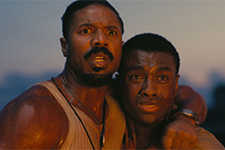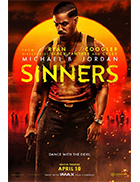Sinners
|  With Sinners, Ryan Coogler is going for broke. Eschewing all the rules while playing with the kind of full deck only afforded by working with a major Hollywood studio—an above-the-marquee star, IMAX cameras, a two-and-a-half-hour runtime—Coogler refuses to throw away the shot he earned via the combined box office clout of Creed (2015) and his two Black Panther movies (2018, 2022), constructing a film of bold visual, narrative, and political ambition. The fact that Sinners has turned into a bona fide hit, the kind that people can’t stop talking about, confirms his ambitions, but they just as easily could have blown up in his face. The fact that they didn’t doesn’t make them any less risky in hindsight, and Sinners is exactly the kind of daring, thoughtful, original filmmaking the lack of which critics and audiences have been bemoaning in recent years. Set in Jim Crow Mississippi of 1932 and taking place over a single day, Sinners at first appears to be a period drama about black generational conflict, organized crime, and juke joints. It begins in ominous fashion with Sammie (newcomer Buddy Guy), covered in blood and still-raw wounds, stumbling into the small, clapboard church pastored by his stern father (Saul Williams), so we know that something horrible will transpired at some point. However, for the first hour and a half, Coogler, who both wrote and directed, cannily keeps the horrors at bay while spinning an engaging story about Sammie’s notorious cousins, twin brothers Elijah “Smoke” and Elias “Stack” Moore (both played by Michael B. Jordan), who have returned to their small hometown after spending nearly a decade in Chicago, ostensibly working with Al Capone. Dressed to the nines, armed to the teeth, and determined in their plans, they purchase an abandoned warehouse from the corpulent local Klan leader, the aptly named Hogwood (David Maldonado), with designs to open it as a juke joint that night. They enlist the help of local shop owners Bo Chow (Yao) and his wife Grace (Li Jun Li) to run the bar, aging pianist Delta Slim (Delroy Lindo) to supply the music, and sharecropper Cornbread (Omar Miller) to work the door. Each of the twins also has a romantic entanglement: Stack’s white gregarious ex-girlfriend Mary (Hailee Steinfeld) and Smoke’s wife Annie (Wunmi Mosaku), who he abandoned to pursue the gangster life in Chicago. Coogler stitches all these subplots together in bravura fashion, creating a tapestry of black life in the Deep South that is suffused with both love and loss, ambition and heartbreak, progress and oppression. The weight of institutionalized racism hangs heavy over everything, which makes Smoke and Stack’s aspirations all the more subversive (much like Coogler’s). They may be vicious criminals who deploy violence as a solve-all tool, but they are also charming, clever, and, most important, unwilling to accept the white power structure that is determined to keep them in line (when Hogwood casually refers to them as “boys,” they reply that there are no boys there, just men with men’s money). The film underscores how money opens doors and possibilities, but it doesn’t erase prejudice and hatred, which highlights the bedrock lie of black success in a white-dominated world. Smoke and Stack manage to pull off the feat of opening the juke joint that night, and at first it is a raging success, bringing in an entire community and offering them a bright place to gather in the surrounding darkness. The film’s midpoint is marked by a magnificent one-shot evocation of the history of black music as Sammie and Delta Slim and the other musicians share the screen with the spectral images of black performers yet to come playing music yet to be invented (hip-hop, heavy metal, etc.) as the building figuratively burns down around them. It is the kind of bold, non-narrative intrusion that any sensible studio executive would immediately demand be cut, which is exactly why it is a moment of such intractable brilliance, creating an unexpectedly beautiful, moving tribute to cultural, musical, and racial history—right before it all hits the fan. And that is when the vampires arrive, and Sinners turns into an entirely different film. Some have argued that the film’s second half, which becomes an unabashed horrorshow that mines both the psychological horrors of loved ones becoming monsters and the physicals horrors of bloodshed and bodily rupture, as well as stylized action-movie tropes, is a lesser achievement than the first half. And there might be some validity in that argument, but only if you ignore the value of Coogler’s midway-switch audaciousness. Although we are drawn in by the intertwining subplots, Coogler still foreshadows what is to come and establishes the presence of the vampires early on. When they arrive at the juke joint—the Irish leader Remmick (Jack O’Connell) and his recently turned victims, a Klan couple named Bert (Peter Dreimanis) and Joan (Lola Kirke)—their presence is threatening not because they are vampires, but because they are white. Their shallow entreaties of racial harmony ring hollow, which merges their racism and vampirism. Vampirism has long offered itself to metaphor on page and screen, its visceral nature naturally aligning with everything from addiction, to colonialism, to contagion. It is one of the primary reasons why the myth of the vampire continues to resonate with such power and work across so many boundaries and why it is so often deployed as a descriptor in critical writing (Karl Marx described capital as “dead labour which, vampire-like, lives only by sucking living labour, and lives the more”). Coogler clearly recognized this, and he cannily uses vampirism as a metaphor for “color blindness”; once people are turned into vampires, their race ceases to matter (at least to them) because all that matters is being a vampire. But, that also means that their history and culture, the very subject of the film’s first half, necessarily also disappears, subsumed by wanton bloodlust. The fact that the increasingly large hoard of vampires outside the juke joint is a rainbow coalition of white, black, and Asian doesn’t make it any less monstrous; in fact, the erasure of difference, something that should be celebrated, not disdained, becomes a central component of their monstrousness. The film’s narrative and thematic ambitions are matched by its visuals, which Coogler and cinematographer Autumn Durald Arkapaw, who shot Coogler’s previous film Black Panther: Wakanda Forever (2022), created with IMAX 70mm cameras. Using shifting aspect ratios and a bold palette that ranges from Technicolor-esque sunsets to Expressionistic darkness, Sinners is a visual feast and testament to the resilient grandeur of the big-screen experience (no wonder it has set records on IMAX screens). Coogler’s multi-genre approach is eclectic, but thoughtful, and his most brash decisions have an internal logic that makes the film feel coherent, smooth, and balanced, even when it is seems to be spinning wildly out of control. Coogler’s masterful evocation of intertwined mythical and political horrors gives Sinners a visceral punch that so many Hollywood movies lack. Going for broke was worth it. Copyright © 2025 James Kendrick Thoughts? E-mail James Kendrick All images copyright © Warner Bros. |
Overall Rating: 


 (4)
(4)


